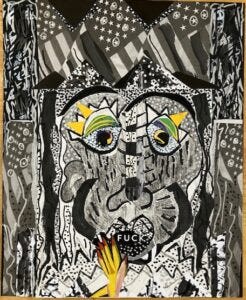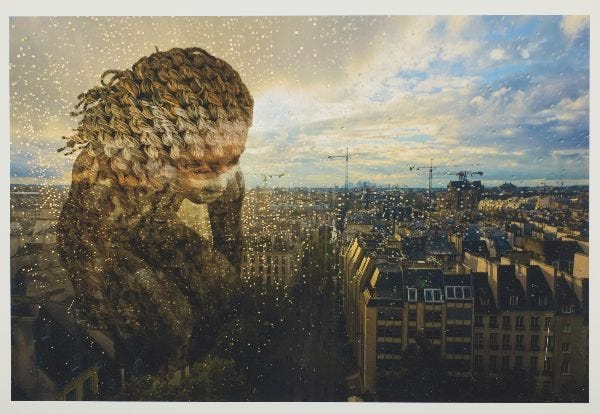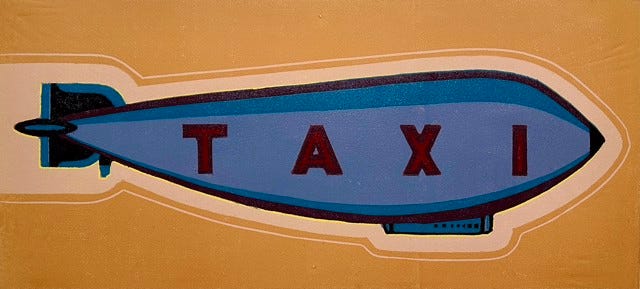Building Projects
Four artists construct "UnFoldings"; Michael B. Platt layers people and places; Kathleen Callery and Marsha Staiger share color schemes; and Dairan Fernández de la Fuente dreams of travel
Judy Greenberg, untitled (Klagsbrun Studios)
AN ALTERNATIVE TITLE FOR THE GROUP SHOW AT KLAGSBRUN STUDIO might be "Repurposings." The four local artists represented in "UnFoldingS" dissect and reassemble boxes, books, and other artifacts, mostly made of paper. The results are complex and diverse, and often suggestive of earlier eras.
Curated by Vesela Sretenović, the exhibition begins conceptually with Julie Wolfe's "The Beholder," a wall-covering installation of pages from an art book she made in collaboration with writers and other artists. The book overlays fussy images from the Rococo era with text and colorful drips and splashes. Wolfe arrayed pages from the volume, apparently at random, and interspersed them with creased sheets of shiny gold paper. The single-color papers, bright and reflective, intriguingly interrupt the flow of printed pages.
The opposite wall is dominated by Enise Carr's "Tarp," a vast collage-painting whose richly textured expanse is divided by white gutters into segments, mostly equal-sized squares. Atop the weathered surface are fabric segments and bits of tape, distinct from and yet congruent with rest of the composition. Carr, who's also showing a sequence of battered near-orbs, pivots between order and chaos.
Sharapat Sarsenova Kessler is one of two participants whose style recalls Russian and Soviet Constructivism. Originally from Kazakhstan, the artist carves paper and cardboard into segments she uses to construct collages that include a puppet-like figure and a set of architectural arches, more impromptu than ceremonial. Inspired by her childhood exposure to quilt-making, Kessler builds things that seem as human as they are geometric.
There's also an echo of Constructivism in the 3D collages of Judy Greenberg, who served as the director of the Kreeger Museum from 1994 to 2017. She made three sets of stacked boxes, with Cubist-influenced drawing-collages pasted to their surfaces. While the box form is inherently tidy, Greenberg's approach is intuitive and emotional, notably in reaction to the current political situation. The mouth of a cut-together face spits a single expletive, small but potent. The country Greenberg observes seems to be not merely unfolding but unraveling.
Michael B. Platt, “Pompidou”
PHOTO-BASED ARTIST MICHAEL B. PLATT (1948-2019) often superimposed images, but the effects were rarely as ghostly as in "Layered Lightnin': The Collaged Portraiture of Michael B. Platt." The Eaton Workshop exhibition, curated by Gia Harewood, includes some familiar elements: nude women, body paint, graceful motion, and a sense of spiritual connection between Black Americans and people of the global South, especially Australian aboriginals. But also featured are lesser-seen elements of the digital-collagist's work, notably scenes of enclosed spaces and the city of Paris.
The exhibition features one wall of documentary artifacts such as photos of Platt and his friends and a few pages, never exhibited before, from the artist's sketchbook. There are also, as is usual in Platt's shows, poems by his spouse, Carol A. Beane. One engrossing composition, in which a seated nude appears in triplicate, echoes the motifs of the artist's late-period work, in which photographic duplication evokes mythic power.
In many of the other pictures, women spiral, float, swim, or ascend. Their motions appear tangible, yet their bodies look ethereal. Platt's human subjects tend to meld with their surroundings, which are often primal, earthy, and open-air. This selection features more urban and interior settings, so the link between body and environment seems less organic. Translucent figures stand in rooms they don't seem to inhabit fully. These elegant apparitions can be read in two ways: as women who haunt the Old World, or are haunted by it.
Kathleen Callery, “Daffodils with 3/5th Purple Gray” (detail) (Athenaeum)
SUNNY YELLOWS AND SKY BLUES ARE THE MOST CONSPICUOUS THINGS THAT LINK the paintings of Kathleen Callery and Marsha Staiger, who are showing together at the Athenaeum. Callery paints daffodils with a gently impressionistic yet detailed approach, while Staiger makes painted and collaged abstractions that emphasize color, line, and what her statement calls "cadence."
Some of Callery's pictures depict blooms in the context of a garden, highlighted but not detached. More often, though, the flowers are fixed on blocks of solid color. Two of the paintings are actually split between daffodils and single-hue rectangles, edging the artist's work closer to color-field painting. Yet the artist's technique, which employs diaphanous oil pigments and occasional touches of gold leaf, is more classical than modernist. Or perhaps it's more apt to say that Callery's quest for the "universal" daffodil is timeless.
Staiger stacks multiple swathes, whether soft- and hard-edged, of mostly bright colors. Occasional black bars surprise the viewer, as do one picture's discreet array of green drips. Some pictures are framed, while others are on large banners, suggesting funky varieties of flags. The artist's note indicates that compositions are intuitive, and thus in the improvisational tradition of mid-20th-century abstract expressionists. Like those artists, Staiger is playing a visual form of jazz.
Dairan Fernández de la Fuente, “Taxi Volador” (Amy Kaslow Gallery)
TRAVEL IS A MOTIF IN DAIRAN FERNÁNDEZ DE LA FUENTE'S ART, but the journeys he depicts are mostly into the past. "Cuban Chronicle," the Havana artist's Amy Kaslow gallery show, includes a half dozen paintings and a few drawings. Yet most of the works are woodblock prints whose streamlined style recalls early-20th-century European travel posters. Often emblazoned with a single word or a simple phrase, prints or paintings highlight a train, a blimp, a motor scooter, or an ocean liner, as well as many beach scenes. The images suggest advertisements that might have been posted on the Paris -- or perhaps Madrid -- Metro a century ago.
Del la Fuente is a first-generation Cuban, the son of immigrants from Spain. "Departures and displacement" are among his themes, according to his statement. What roots his bold-colored prints in his homeland is the use of techniques employed by 19th-century designers of Cuban cigar label makers. This is another bow to a vanished epoch, quaint yet vibrant.
Along with beaches, the artist's favored subjects include sports and bathrooms, the latter sometimes in use. A gently surrealist sensibility is revealed mostly by unnaturalistic hues, notably green skin. There's also a print in which a surfer heads toward the waves carrying not a surfboard but an ironing board. This may be an offhand whimsy, but it can also be read as an acknowledgement of dreary reality: Del la Fuente's scenarios are merely fantasies of escape, not actual portals to an enchanted world.
UnFoldingS
Through May 23 at Klagsbrun Studios, 1662 33rd St. NW. klagsbrunstudios.com.
Michael Platt: Layered Lightnin': The Collaged Portraiture of Michael B. Platt
Through May 20 at Eaton Workshop, 1201 K St. NW. eatonworkshop.com/en-us/washington-dc/
Kathleen Callery/Marsha Staiger
Through May 25 at the Athenaeum, 201 Prince St., Alexandria. nvfaa.org. 703-548-0035.
Dairan Fernández de la Fuente: Cuban Chronicle
Through May 18 at Amy Kaslow Gallery, 7920 Norfolk Ave., Bethesda. amykaslowgallery.com.




